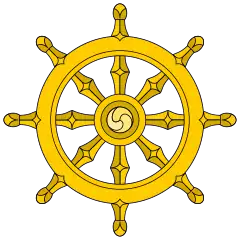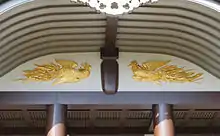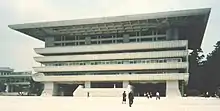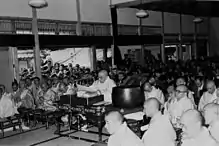Nichiren Shōshū
Nichiren Shōshū (Kanji: 日蓮正宗, English: Orthodox School of Nichiren) is a branch of Nichiren Buddhism based on the teachings of the 13th-century Japanese Buddhist priest Nichiren (1222–1282), claiming him as its founder through his disciple Nikko Shonin (1246–1333), the founder of Head Temple Taiseki-ji, near Mount Fuji. Nichiren Shōshū lay adherents are called Hokkeko members. The Enichizan Myohoji Temple located in Los Angeles, California serves as the organization's headquarters within the United States.
 Nichiren Shoshu Buddhism | |
|---|---|
| 日蓮正宗 | |
 | |
| Abbreviation | NST |
| Classification | Nichiren Buddhism |
| Scripture | Lotus Sutra Gosho writings of Nichiren |
| Theology | Hokke Buddhism |
| High Priest | Nichi Nyo Shonin |
| Liturgy | Liturgy of Nichiren Shoshu |
| Headquarters | Taiseki-ji |
| Founder | Nichiren Daishonin |
| Origin | 1290 Minobu, Yamanashi, later transferred to Taisekiji |
| Members | 628,000 lay members (December 2017) |
| Official website | Nichiren Shoshu Website |
| Logo | Round crane |
The sect is based on the teachings of Nichiren. Its main object of worship is the Dai Gohonzon, and its logo is the round crane bird (Japanese: Tsuru-no-Maru). Both its leadership and adherents ascribe the honorific title to Nichiren, as the “Original True Buddha” (御本仏: “Go-Honbutsu”) and the Dai-Shonin (Great Teacher) while maintaining that the sole legitimate successor to both his ministry and legacy is Nikko Shonin alone and the successive high priests of Nichiren Shōshū, lead by the current High Priest of the sect, Hayase Myoe Ajari Nichinyo Shonin, who ascended to the position on 15 December 2005.
Overview

| Part of a series on |
| Buddhism |
|---|
 |
|
Nichiren Shōshū is a Mahayana Buddhist sect. Its original name is Nichiren School (Shu) of the Fuji area, branch of Taisekiji Temple, indicating the general naming of sects at the time, though not united, and then divided in different localized traditions. After the Meiji restoration, it was given its own name, Nichiren Shoshu, in 1912. Its head temple Taiseki-ji, is located on the lower slopes of Mount Fuji in Japan. Taiseki-ji is visited regularly by Nichiren Shōshū believers from around the world who come to chant to the Dai Gohonzon, which they claim was described by Nichiren as ”…the essence of my Buddhahood written in Sumi Ink.”
Unlike other Mahayana Buddhist practices, Nichiren expounded the Lotus Sutra and chanting Nam-myōhō-renge-kyō as a way for anyone to obtain Enlightenment regardless of one's position in life, condition of circumstances, gender and occupational role as well as not necessarily waiting to be reincarnated into another future existence.[1]
Nichiren Shōshū claims over 700 local temples and additional temple-like facilities (propagation centers) in Japan. It also claims 24 overseas official designated temples and 678,000 registered members.
Nichiren Shōshū claims a direct lineage, called Yuijo Ichinen Kechimyaku Sojo, of successive High Priests from Nikko Shonin, who they believe was chosen by Nichiren to carry on the propagation of his Buddhist practice in the Latter Day of the Law, a claim that other Nichiren Buddhist sects assert as well, such as Nichiren-shū.[2] Nichiren Shōshū claims this lineage is set forth in the following Nichiren documents:
- The Law that Nichiren propagated throughout his life (Nichiren ichi-go guho fu-zo-ku-sho)
- The Ikegami Transfer Document (Minobu-Sanfu-Zokusho)
- The 106 Articles of Nichiren Shōshū (Hya-Ku-Rokka-Sho)
The current leader of the sect is the 68th High Priest, Nichinyo Shōnin (1935–). Nichiren Shōshū priests distinguish themselves from those of most other schools by wearing only white and grey vestment robes and a white surplice, as they believe Nichiren did. Since the Meiji period, Nichiren Shōshū priests, like other Japanese Buddhist sects, have been permitted to marry.
Hokkeko
Lay believers belong to official congregations known as Hokkekō groups, designed to encourage solidarity among fellow members to study the Nichiren Shoshu doctrines and plan one's Tozan pilgrimage to the head temple in Japan. Most attend services at a local temple or in private homes when no temple is nearby. Services are usually officiated by a priest, but lay leaders sometimes fill in when no priest is available. When they gather, believers frequently study Nichiren Shōshū teachings, particularly the various writings of Nichiren, called Gosho. A leader in a local group or district is called Koto while a widely held position on a grander scale was once called So-Koto, now expired and no longer used. The present Dai-Koto leader of the Hokkeko Federation is Mr. Koichiro Hoshino.
The official symbol of Nichiren Shōshū is the crane bird (Tsuru). More specifically, the posture of the crane is in a circular position (Tsuru-no-Maru). Another symbol is the eight wheel of Noble Eightfold Path called Rimbo (Treasure Ring) used by all Buddhist sects, as well as the tortoise crest for Nikko Shonin, who is considered by the school to be the sole and legitimate successor to Nichiren. The Three Friends of Winter combination crest is also present in the temple altars, representing Nichimoku Shonin.
Doctrine

Nichiren Shōshū doctrine extends the Tiantai classification of the Buddhist sutras into five time periods and eight categories (五時八教: goji-hakkyō), its theory of 3,000 interpenetrating realms within a single life-moment (一 念 三 千: Ichinen Sanzen), and its view of the Three Truths (三諦: Santai). In addition, the school holds that in revealing and propagating his teachings, Nichiren was fulfilling a prophecy made by the Shakyamuni Buddha; 563?–483? BC) in the 21st chapter of the Lotus Sutra which states the following:
Like the rays of the sun and the moon that dispel the darkness of phenomena, this person will practice in the world, dispel the darkness of all humanity and lead immeasurable numbers of bodhisattvas to finally attain the one vehicle.
- (Namu Butsu) - Nichiren Shōshū teaches that Nichiren is the True Buddha for the modern age corresponding to the present Buddhist age and on for eternity—for this reason by referring to him as Nichiren Daishōnin ("Great Sage Nichiren").
- (Namu Ho) - The Dharma, or Mystic Law (Myōhō: mystic in the sense of profound, sublime, or unfathomable), is the True Buddha's ultimate teaching, crystallized in Nam Myōhō Renge Kyō.
- (Namu So) - The Sangha refers to the collective of Nichiren Shōshū priests who serve to protect and preserve the doctrines and dogma of Nichiren Shōshū.
The Three Great Secret Laws
According to the doctrinal beliefs of Nichiren Shoshu, Nichiren instituted the mastery three spiritual disciplines:
- Precepts - designed to help practitioners replace the negative causes that they tend to make with positive ones.
- Meditation - designed to tranquil and focus the mind towards purity.
- Wisdom - designed to discern the causes of negative passions and desires and embody the Buddhist universal truth.
Nichiren Shoshu teaches that Nichiren revealed the Three Great Secret Laws:
- The Dai-Gohonzon as the Supreme Object of Worship, sourcing to the vow of Precepts.
- The Daimoku of Nam Myoho Renge Kyo as the Supreme Invocation, sourcing to its meditational practice.
- The Dai-Sekiji no Honmon Kaidan (Tai-sekiji) as the Platform of the High Sanctuary of Essential Teaching, sourcing to its authoritative office of Wisdom.
Ceremonies
Several ceremonies are conducted within Nichiren Shoshu, some as memorials for lauded figures, others in commemoration or celebration of momentous events, as well as life-cycle event ceremonies for individuals including conversion to Buddhism, marriages and funerals. One of the important ceremonies is called Gojukai, which is a ceremony for the "Acceptance of the Precepts". Gojukai literally means "to receive the precept".This ceremony is conducted when a person converts to the faith and practice of Nichiren Buddhism and involves the recipient vowing to uphold the teachings of Nichiren Daishonen. The ceremony, officiated by a priest, involves the recitation of the Lotus Sutra, Gongyo, followed by chanting of Daimoku, Shodai, and an observance of the silent prayers. The officiating priest will then administer the oath of acceptance in which three questions are asked to the recipient, who answers "I do".
Daily practice

Nichiren Shōshū teaches that personal enlightenment can be achieved in one's present form and lifetime (即身成仏 sokushin jōbutsu). Chanting Nam-Myōhō-Renge-Kyō is central to their practice. Only by chanting Nam-myōhō-renge-kyō to the Gohonzon is a person believed to change, or expiate, bad karma and achieve enlightenment. In this process, the individual chooses to lead others to an enlightened state of being.
Nam-Myōhō-Renge-Kyō is called the Daimoku (題目: "title"), since it comprises Nam and the Japanese title of the Lotus Sutra, Myōhō-Renge-Kyō. It can be understood as a sort of invocation meaning "I submit myself (or "dedicate, commit my life") to the Mystic Law containing the Cause and Effect of the enlightenment of all Buddhas." The believer's practice (gyōriki: power of practice) and faith (shinriki: power of faith) are believed to call forth the power of the Buddha (butsuriki) and the power of the Dharma (Law) inherent in the Gohonzon (hōriki). This practice and faith are thought to expiate the believer's "negative karma", and bring forth a higher life condition.
The daily practice of Nichiren Shōshū believers consists of performing gongyō (chanting) twice daily, once in the morning and once in the evening. Gongyō entails chanting a portion of Chapter 2 (Expedient Means) and all of Chapter 16 (Life Span of the Thus Come One) of the Lotus Sutra and chanting Nam-Myōhō-Renge-Kyō to the Gohonzon, while focusing on the Chinese character 妙 [Japanese: myō] (Eng. Mystic; Wonderful), the second character of the Daimoku.
Morning gongyō consists of a series of five sutra recitations followed by silently recited, prescribed prayers. Evening gongyō encompasses only three sutra recitations and the second, third, and fifth of the same silent prayers. This practice, particularly when shared with others, is regarded as the "true cause" for attaining enlightenment. A traditional bell is used to announce prayers for the Buddhist protection gods of Shoten Zenjin as well as to announce the dead relatives prayed for during Gongyo services.
Object of worship

The Dai Gohonzon (Also Called: Dai-Gohonzon of the High Sanctuary of Essential Teachings) is a calligraphic mandala inscribed with Sanskrit and Chinese characters on a plank of Japanese camphorwood and the supreme object of veneration for the Shōshū school. The Nichiren Shōshū school claims that Nichiren inscribed it on 12 October 1279 (Japanese: Koan).
The religious importance of this item to Nichiren Shoshu is that the sect claims the ninpō-ikka or "unity of the Person and the Buddhist Law" and the Dai Gohonzon is revered as the personification of Nichiren himself. Every Nichiren Shōshū temple and household possesses a gohonzon that the sect claims is a transcription of the Dai Gohonzon.
The Dai Gohonzon is enshrined at the Hoando worship hall [3] within the Taiseki-ji Grand Main Temple complex grounds at the foot of Mount Fuji. The temple priesthood will only expose the image for constant public veneration once Kosen-rufu is achieved, maintaining the beliefs of Nichiren Shōshū as the primary religion in the world. Unlike the other Gohonzons enshrined at the Head Temple, it is not enshrined with shikimi branches.

Transcriptions of the Dai Gohonzon, made by successive High Priests of Nichiren Shōshū, are called gohonzon (go, honorific prefix indicating respect). Most gohonzons in temples are wood tablets in which the inscription is carved; the tablets are coated with black urushi and have gilded characters. Gohonzons enshrined in temples and other similar facilities are personally inscribed by one of the successive High Priests.
Hokkeko followers may make a request to receive a personal gohonzon to their local temple chief priest. These gohonzons are facsimiles printed on paper and presented as a small scroll, measuring approximately 7" x 15" inches. The local chief priest sends all requests to the Head Temple. As these requests are granted, gohonzons are then delivered to the recipient's local priest and he bestows them on the individual members. In this ritual, the recipient vows to sincerely believe in Nichiren's teachings and to practice and uphold the gohonzon of the Three Great Secret Laws.
List of High Priests
| Rank | High Priest | Date of Birth | Date of Death |
|---|---|---|---|
| 1 | Nichiren Daishonin | 16 February 1222 | 13 October 1282 |
| 2 | Nikko Shonin | 8 March 1246 | 7 February 1333 |
| 3 | Nichimoku Shonin | 28 April 1260 | 15 November 1333 |
| 4 | Nichido Shonin | 1283 | 26 February 1341 |
| 5 | Nichigyo Shonin | Unrecorded | 13 August 1369 |
| 6 | Nichiji Shonin | Unrecorded | 4 June 1406 |
| 7 | Nichi a Shonin | Unrecorded | 10 March 1407 |
| 8 | Nichi-ei Shonin | 7 November 1353 | 4 August 1419 |
| 9 | Nichiu Shonin | 16 April 1402 | 29 September 1482 |
| 10 | Nichijo Shonin | Unrecorded | 20 November 1472 |
| 11 | Nittei Shonin | Unrecorded | 7 April 1472 |
| 12 | Nitchin Shonin | 1469 | 24 June 1527 |
| 13 | Nichi-in Shonin | 1518 | 6 July 1589 |
| 14 | Nisshu Shonin | 1555 | 17 August 1617 |
| 15 | Nissho Shonin | 1562 | 7 April 1622 |
| 16 | Nichiju Shonin | 1567 | 21 February 1632 |
| 17 | Nissei Shonin | 1600 | 5 November 1683 |
| 18 | Nichi-ei Shonin | 3 March 1594 | 7 March 1638 |
| 19 | Nisshun Shonin | 1610 | 12 November 1669 |
| 20 | Nitten Shonin | 1611 | 21 September 1686 |
| 21 | Nichinin Shonin | 1612 | 4 September 1680 |
| 22 | Nisshun Shonin | 1637 | 29 October 1691 |
| 23 | Nikkei Shonin | 1648 | 14 November 1707 |
| 24 | Nichi-ei Shonin | 1650 | 24 February 1715 |
| 25 | Nichiyu Shonin | 1669 | 28 December 1729 |
| 26 | Nichikan Shonin | 7 August 1665 | 19 August 1726 |
| 27 | Nichiyo Shonin | 1670 | 4 June 1723 |
| 28 | Nissho Shonin | 1681 | 25 August 1734 |
| 29 | Nitto Shonin | 3 March 1689 | 1 December 1737 |
| 30 | Nitchu Shonin | 1687 | 11 October 1743 |
| 31 | Nichi-in Shonin | 17 October 1687 | 14 June 1769 |
| 32 | Nikkyo Shonin | 1704 | 12 August 1757 |
| 33 | Nichigen Shonin | 15 August 1711 | 26 February 1778 |
| 34 | Nisshin Shonin | 1714 | 26 July 1765 |
| 35 | Nichi-on Shonin | 1716 | 3 July 1774 |
| 36 | Nikken Shonin | 1717 | 3 October 1791 |
| 37 | Nippo Shonin | 23 January 1731 | 26 May 1803 |
| 38 | Nittai Shonin | 1731 | 20 February 1785 |
| 39 | Nichijun Shonin | 1736 | 30 July 1801 |
| 40 | Nichinin Shonin | 1747 | 25 August 1795 |
| 41 | Nichimon Shonin | 1751 | 14 August 1796 |
| 42 | Nichigon Shonin | 1748 | 11 July 1797 |
| 43 | Nisso Shonin | 1759 | 3 December 1805 |
| 44 | Nissen Shonin | 1760 | 7 January 1822 |
| 45 | Nichirei Shonin | Unrecorded | 8 May 1808 |
| 46 | Nitcho Shonin | 1766 | 27 January 1817 |
| 47 | Nisshu Shonin | 1769 | 22 September 1816 |
| 48 | Nichiryo Shonin | 18 February 1771 | 29 May 1851 |
| 49 | Nisso Shonin | 1773 | 8 May 1830 |
| 50 | Nichijo Shonin | 1795 | 1 May 1836 |
| 51 | Nichi-ei Shonin | 1798 | 9 July 1877 |
| 52 | Nichiden Shonin | 25 August 1817 | 24 June 1890 |
| 53 | Nichijo Shonin | 11 October 1831 | 25 June 1892 |
| 54 | Nichi-in Shonin | 16 March 1829 | 2 June 1880 |
| 55 | Nippu Shonin | 5 February 1835 | 4 March 1919 |
| 56 | Nichi-o Shonin | 1848 | 15 June 1922 |
| 57 | Nissho Shonin | 24 May 1865 | 26 January 1928 |
| 58 | Nitchu Shonin | 18 December 1861 | 18 August 1923 |
| 59 | Nichiko Shonin | 24 February 1867 | 23 November 1957 |
| 60 | Nichikai Shonin | 23 August 1873 | 21 November 1943 |
| 61 | Nichiryu Shonin | 10 August 1874 | 24 March 1947 |
| 62 | Nikkyo Shonin | 18 September 1869 | 17 June 1945 |
| 63 | Nichiman Shonin | 5 March 1873 | 7 January 1951 |
| 64 | Nissho Shonin | 24 September 1879 | 14 October 1957 |
| 65 | Nichijun Shonin | 10 October 1898 | 17 November 1959 |
| 66 | Nittatsu Shonin | 15 April 1902 | 22 July 1979 |
| 67 | Nikken Shonin | 19 December 1922 | 20 September 2019 |
| 68 | Nichinyo Shonin | 25 February 1935 | Current High Priest (Incumbent) |
- The dates denote the date of death of each high priest.
Expelled lay and priestly groups
The following groups, which had been associated with Nichiren Shoshu, were expelled in the years 1974 (Kenshokai), 1980 (Shoshinkai), and 1991 (Soka Gakkai).
Kenshokai (顕正会) — (1974)
In 1974, a lay group called Myōshinkō from the Myokoji Temple in Shinagawa ward in Tokyo was expelled by High Priest Nittatsu Hosoi from Nichiren Shōshū after holding a public protest against Soka Gakkai for claiming that the Shohondo building was the true and permanent national sanctuary of the Dai Gohonzon as mandated by Nichiren, even without the conversion of Emperor Showa. The group was known for being brazen in confronting Soka Gakkai and being confrontational with the late Nittatsu Shonin, resulting in a lawsuit against him amidst public protest. They are known for reciting two Hiki-Daimoku and one regular, a developed practice that has unknown origins. The group is highly devoted to the Dai Gohonzon enshrined at Taisekiji even without the support or affiliation of Nichiren Shōshū.
The group later changed its name to Fuji Taisekiji Kenshōkai. Kenshōkai has been described as one of the fastest growing denominations of Buddhism in Japan.[4] The Kenshokai uses an enlarged, variant copy of the Dai Gohonzon image from the year 1728 by Nichikan Shonin, the 26th High Priest of Head Temple Taisekiji. The image uses the exact same brown ornamental border used by Nichiren Shoshu.
Shōshinkai (正信会) — (1980)
In 1980, a group of Nichiren Shōshū priests and lay supporters called Shōshinkai (English: Correct Faith Group) were expelled from the Head Temple by 67th High Priest Nikken Shonin for questioning the legitimacy of the new head abbot Nikken and for criticising Soka Gakkai's influence on temple affairs. At the time, Soka Gakkai supported Nikken's claim to be the rightful successor of Nittatsu Hosoi as high priest. Shōshinkai continues to refer to itself as the true Nichiren Shōshū. Shōshinkai later founded a dissident association of Nichiren Shoshu priests seeking reformation and began transcribing their own version of the Gohonzon rather than taking a transcribed copy from one of the Nichiren Shōshū high priests. Most of them have aged or deceased, and their temples have since reverted back to Nichiren Shoshu administration after their death, having been replaced with younger priests affiliated with the Head Temple Taiseki-ji. Some of these older priests have also joined other Nichiren sects or made their own, such as the case in Taiwan. [5][6]
Soka Gakkai (創価学会) — (1991)

Nichiren Shōshū excommunicated the Soka Gakkai and the Soka Gakkai International (SGI) on 28 November 1991.[7][8]
Soka Gakkai had emerged as a lay organization affiliated with one of the temples located in the Taiseki-ji land complex, founded by Tsunesaburo Makiguchi, who was converted by Sokei Mitani, the principal of Meijiro Kenshin Junior and Senior High School to Nichiren Shoshu on 4 June 1928. The organization grew under second president Jōsei Toda, and continued to base its teachings on Nichiren Shōshū until the development of doctrinal conflicts with the third Soka Gakkai President and Soka Gakkai International president, Daisaku Ikeda.
As early as 1956, such doctrinal conflicts simmered, evident by the alleged declaration of second president of Soka Gakkai, Josei Toda to the 65th High Priest Nichijun Shonin during the reconstruction of Myoden-ji Temple, claiming the organizational leadership no longer upheld Nichiren Shoshu doctrines.[9]
On 10 May 1974, the Vice-President of Soka Gakkai, Hiroshi Hojo, submitted a written report to Daisaku Ikeda proposing a schism with Nichiren Shōshū, using the example of Protestants and Roman Catholics as "differences". In response, High Priest Nittatsu Hosoi refused the proposal to create a board committee that would oversee temple affairs and its bookkeeping practices, while mentioning his gratitude for the construction of the Shohondo building. Furthermore, Nittatsu acknowledged the possibility of the split, and specifically threatened to place the Dai-Gohonzon back into the Nichiren Shōshū treasury building (御宝蔵: Gohōzō) where only a select few faithful would be able to venerate the image. The climax which ultimately led to the resignation of third president Daisaku Ikeda in 1979 from his post as Sokoto or lay leader went hand in hand with the formal excommunication by High Priest Nikken Abe.
These and other conflicts resulted in a complete and formal disassociation of the two sides after Nichiren Shōshū excommunicated the leaders of the Sōka Gakkai and stripped it of its status as a lay organization of Nichiren Shōshū in 1991. Ultimately, Daisaku Ikeda was excommunicated from the role of Sokoto or lay leader by High Priest Nikken, while the formal decree of excommunication invalidated the tax exempt status of Soka Gakkai under Japanese law due to its lack of temple affiliation.
Further causes of conflict came when the temple priesthood began to notice the construction of Community Centers instead of funding construction of new Nichiren Shōshū temples. On 30 September 1997, Nichiren Shōshū finally excommunicated all Soka Gakkai International members.[10][11]:69
Opposing views
Most significant is the alleged monopoly of Nichiren Buddhism through the devotional Tozan pilgrimages to the Dai Gohonzon, alleging it to be a forgery, unsubstantiated by historical provenance, stolen and hostaged, or outright commercialized for either profit or exclusivity.[12]
The opinion of academic researchers such as American author Daniel Alfred Metraux,[13] claims the issue of doctrinal authority as the central point of the conflict:
“The (Nichiren Shoshu) priesthood claims that it is the sole custodian of religious authority and preservation of dogma, while the Soka Gakkai leadership claims that the scriptural writings of Nichiren, not the priesthood, represent the ultimate source of authority, and that any individual with deep faith in Nichiren's teachings can attain enlightenment without the assistance of a Nichiren Shōshū priest.”[14][15]
See also
References
- International (SGI), Soka Gakkai. "On Attaining Buddhahood in This Lifetime | Soka Gakkai International (SGI)". www.sgi.org. Retrieved 2020-05-29.
- Bromley, David G.; Hammond, Phillip E.; Seminary), New Ecumenical Research Association (Unification Theological (1987). The Future of New Religious Movements. Mercer University Press. ISBN 978-0-86554-238-9.
- https://www.nichirenshoshu.or.jp/eng/taisekiji-buildings.html
- Stone, Jacqueline (2012). "The Sin of "Slandering the True Dharma"". Sins and Sinners: Perspectives from Asian Religions. Brill. p. 147. ISBN 978-9004229464.
- Shoshū Hashaku Guide (Jp: 諸宗破折ガイド: Guide to refuting [erroneous teachings of] other schools). Taiseki-ji, 2003 (no ISBN); pp. 178–79.
- http://sokaspirit.org/home/newsletter/the-myosetsu-ji-chief-priest-responds/
- http://sokaspirit.org/nov-28-1991-sgi-day-of-spiritual-independence-2/
- https://www.nst.org/sgi-faqs/the-history-of-the-relationship-between-nichiren-shoshu-and-the-soka-gakkai/4-events-leading-to-excommunication-of-soka-gakkai/
- http://sokaspirit.org/home/newsletter/former-los-angeles-priest-speaks-out/
- http://sokaspirit.org/world-tribune/editorial-excommunicating-the-excommunicated/
- McLaughlin, Levi (2012). "Did Aum Change Everything? What Soka Gakkai Before, During, and After the Aum Shinrikyo Affair Tells Us About the Persistent "Otherness" of New Religions in Japan". Japanese Journal of Religious Studies. 39 (1): 51–75. Archived from the original on 2013-12-23.
- Clarke, Peter B.; Somers, Jeffrey (2013-10-18). Japanese New Religions in the West. ISBN 9781134241385.
- https://mellenpress.com/author/daniel-a-metraux/6483/
- D. Metraux, "The dispute between the Sōka Gakkai and the Nichiren Shōshū priesthood: A lay revolution against a conservative clergy", Japanese Journal of Religious Studies. Vol 19 (4), p. 326, 1992. Archived from the original
- Reader, Ian (1995). "Review of "A Time to Chant" by Wilson and Dobbelaere". Japanese Journal of Religious Studies 22 (1-2), 223
